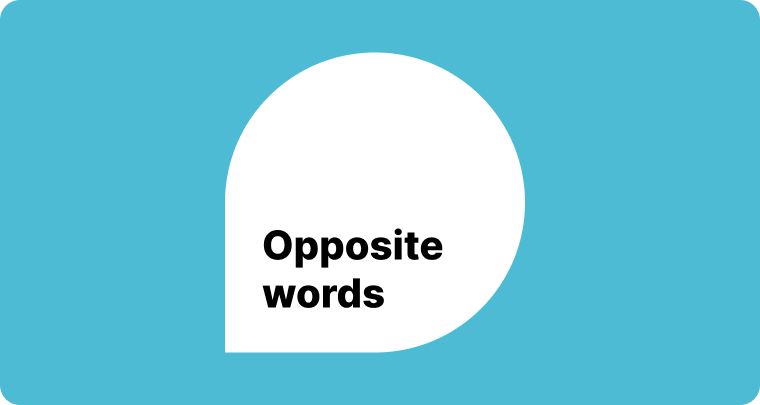
Do you want to expand your vocabulary? If you’ve ever struggled to find the right words or lost a game of Scrabble due to a limited word bank, learning opposite words—also called antonyms—can be an effective way to strengthen your language skills.
Antonyms play a crucial role in communication by adding contrast, depth, and variety to our speech and writing. Whether distinguishing between simple concepts like hot and cold or more abstract ideas like liberty and restriction, opposite words help us express thoughts with greater clarity and precision.
In a world where yes and no shape decisions, where up and down define movement, and where good and bad set moral boundaries, understanding opposites is an essential aspect of mastering language.
Let’s explore the significance of antonyms and how they can enrich your ability to communicate effectively.
What Are Opposite Words?
Opposite words, or antonyms, are terms with meanings that contrast one another. Unlike synonyms, which share similar meanings, antonyms represent opposing ideas, qualities, or attributes.
For example:
Happy vs. sad
Strong vs. weak
Open vs. closed
Antonyms are valuable linguistic tools that contribute to clarity, accuracy, and expressiveness in communication. They help us emphasize differences, refine our ideas, and make our statements more dynamic.
For instance, in the sentence:
“What unites us is stronger than what divides us.”
The words unites and divides serve as opposites, reinforcing contrast while adding emphasis and poetic balance.
Beyond their role in enhancing clarity, antonyms encourage critical thinking by helping us compare alternatives. In education, science, and decision-making, recognizing opposites allows for better evaluation of choices and improved problem-solving.
When Should You Use Opposite Words?
Antonyms are useful in various situations, particularly when you want to:
- Clarify Meaning
Opposites help differentiate between concepts, making ideas easier to understand. For example, comparing flexible and rigid can highlight differences in approach or mindset. - Express Emotions
When discussing feelings, using antonyms helps to convey emotional contrasts. For example:
She felt excited about the opportunity, while he remained indifferent.
- Describe Characteristics
Antonyms can illustrate opposing traits in people, objects, or situations.
One employee is highly motivated, while another appears disengaged.
- Give Directions
Opposites are helpful in navigation and instructions. For example:
Turn left at the intersection, then take a right at the next street.
- Create Contrast in Writing
Writers and speakers use antonyms to add drama, tension, or contrast to stories, speeches, and arguments.
She was fearless, while her friend was hesitant and uncertain.
- Assist in Decision-Making
Contrasting options using antonyms helps weigh choices effectively.
Is it better to act now or wait for a more favorable moment?
Common Opposite Word Pairs
Let’s look at some commonly used antonym pairs categorized by themes.
To see how antonyms function in everyday language, consider the following examples:
- Emotions
Happy — Sad
Excited — Bored
Joyful — Miserable
Content — Discontented - Size & Magnitude
Big — Small
Massive — Tiny
Huge — Miniature - Qualities & Traits
Good — Bad
Strong — Weak
Honest — Dishonest
Brave — Cowardly - Directions & Positions
Up — Down
Above — Below
In — Out
Front — Back - Colors & Brightness
Light — Dark
Bright — Dull
Pale — Vibrant
Examples of Opposite Words in Sentences
- Emotions
Bradley felt proud of his promotion, but he was disappointed to leave his old team.
The child’s excitement was evident as she opened her gift, while her brother showed no interest. - Size & Magnitude
The enormous elephant moved past the tiny mouse without noticing it.
The towering skyscrapers overshadowed the small shops along the street. - Qualities & Traits
Unlike Martha’s suspicious behavior, which raised concerns, his trustworthy nature made him the ideal candidate.
The determined hiker reached the summit, while his hesitant companion remained at base camp. - Directions & Positions
The plane soared high above the clouds before descending toward the runway.
The spider crawled under the table to escape the rain falling above it. - Colors & Brightness
Dark storm clouds loomed against the bright blue sky, signaling an approaching storm.
The artist painted a colorful rainbow, contrasting sharply with the dull gray clouds.
Why Learning Opposites Helps Language Development
Understanding antonyms improves language skills by strengthening vocabulary, improving comprehension, and making communication more precise. For learners of English or any new language, recognizing opposites enhances fluency by allowing them to express ideas more effectively.
Additionally, antonyms contribute to better reading and listening comprehension, helping learners grasp context, tone, and implied meanings in conversations, books, and media.
Exploring opposites also provides insights into cultural perspectives, as language reflects societal values and beliefs. By studying antonyms, learners develop a deeper appreciation of the language and its nuances.
Frequently Asked Questions (FAQs)
- What are opposite words, and why are they useful?
Opposite words, or antonyms, are words with contrasting meanings. They help clarify ideas, enhance communication, and add depth to language. - How can learning antonyms improve my English?
Studying antonyms expands vocabulary, improves comprehension, and sharpens critical thinking, making communication more precise and engaging. - How are antonyms used in daily conversations?
Opposites are used to describe emotions, compare characteristics, give directions, and create contrasts in storytelling and discussions. - Can understanding antonyms help with learning synonyms?
Yes! Understanding a word’s opposite deepens comprehension and helps learners grasp its full meaning, making it easier to learn synonyms as well.
Final Thoughts
Mastering antonyms is a powerful way to enhance vocabulary, refine communication, and develop critical thinking skills. By actively using opposite words in speech and writing, you can make your language more expressive and engaging.
Whether you’re learning English, expanding your vocabulary, or refining your writing, embracing antonyms will help you navigate language with greater precision and confidence.
